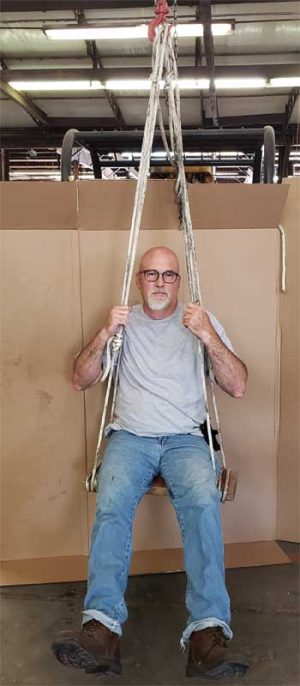Staggering progress

A Boatswain chair consisted of a piece of wood secured on either side of the seat and attached to the crane, which would elevate the installer to the desired height.
The introduction of the hydraulic crane brought with it additional features, including an oversized rotating basket for holding two or more people. A larger work platform meant greater flexibility—an extra set of hands to hold a bigger sign in place or additional material to be carried up if there was only one person in the basket. Another advantage of this basket was the ability to position the sign truck in one location, so the installer could start on one end of the wall and slowly work his/her way across the face of the building. Since the front of the basket stayed parallel to the wall at all times, the worker did not have to lean over the edge of the platform to reach the sign he/she was working on. These baskets became more commonplace as channel letters increased in popularity within the industry.
Soon after this, winch-operated jib cranes and trucks with 180-degree rotation baskets appeared on the scene. These allowed the installer to raise a letter up into place and position it without using his/her hands, or for a sign that was too heavy to lift manually. These devices were lighter and quicker than the main hoists used previously, as they were designed keeping service and light installation requirements in mind. Additional accessories, such as a 110-volt outlet in the basket, became much more common and allowed the use of power tools, such as drills and saws, from within the structure itself. They also allowed workers to conduct electrical tests on signs before they were connected to the main circuits of a pole or building. Welding leads in the basket were helpful when using staggered poles—also known as wedding cake poles—where one pole was lifted from inside the other and welded in place to reach a greater height.
It was around this time pressure washers started to make an appearance. These devices were used to clean algae or mould growth inside awnings and double-faced signs. In this case, a professional was required to come in once or twice a year, turn off the power, open up the faces, and wash the inside of the sign to keep them from developing black spots, which showed up when the sign was illuminated.
Signs of success
Sign truck beds have also changed with the times. Today, it is almost impossible to find a truck set up with hand-painted or printed plywood shelving for large hoardings. Panel signs with front lighting phased out in the ’70s and ’80s, with the exception of a few billboards. Giant chicken wire racks used for large neon signs are not seen anymore, as porcelain and neon, too, gave way to modern pan-faced signs with LED or fluorescent lighting.
Stabilizing jacks or outriggers—used for keeping trucks in position—have also undergone a tremendous change over the years. Today, it is very common to see hydraulic outriggers that are independently controlled; some even have sensors tied to computer levelling systems. That said, sign trucks themselves have evolved in the last 20 to 30 years. In fact, almost no one orders a truck without air conditioning and a radio anymore. These were considered over-the-top luxury items back then. Today’s trucks feature everything from Global Positioning System (GPS) to onboard cameras, remotely guided spotlights for after-hours work, sunroofs to increase visibility when positioning the truck, cruise control, tilt steering, and custom ride seats for long-haul service calls—everything one would
find in a luxury car. Apart from convenience, these items have definitely made the sign installer’s life much easier, safer, and more efficient.
Bryan Wilkerson is vice-president at Wilkie Mfg LLC in Oklahoma. He has been in the industry for 32 years and has been a member of several sign association boards. He is also an advisor to the crane safety board for the Canadian Standards Association (CSA). Wilkerson can be reached at bryan@wilkiemfg.com. For more information, visit www.wilkie mfg.com.





